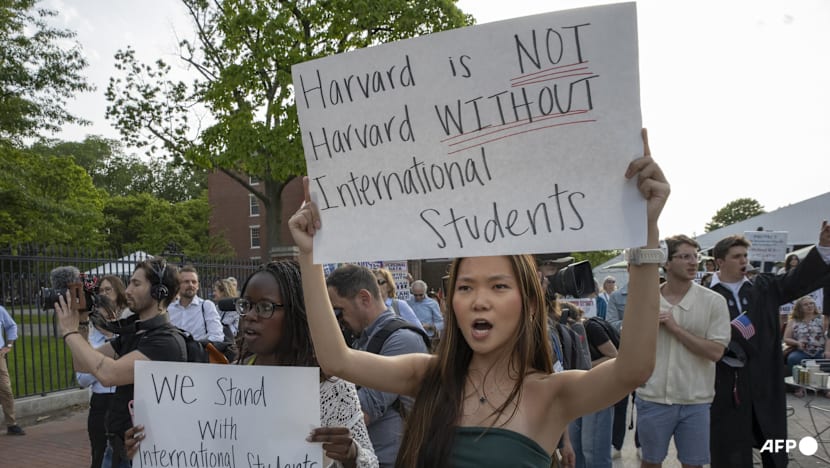Asian student arrivals to US plunge to lowest level since COVID-19 pandemic
The decline coincides with measures adopted by US President Donald Trump’s administration, which include threats to deport foreigners and restrictions on several Asian countries like China.

People hold up signs during the Harvard Students for Freedom rally in support of international students at the Harvard University campus in Boston, Massachusetts, on May 27, 2025. (Photo: AFP/Rick Friedman)

This audio is generated by an AI tool.
The number of students arriving from Asia to the US in August fell by nearly 24 per cent this year compared with last year, according to recently released US government data, marking the lowest August numbers on record outside of the COVID-19 pandemic.
The data, based on arrival records of international students published by the Department of Commerce’s International Trade Administration (ITA), includes both new students and existing students returning to the US. August arrival data typically serve as a reliable indicator of enrolment in US schools as students usually arrive that month in time for the fall semester, which generally starts in August or September.
The decline coincides with a series of measures adopted by US President Donald Trump’s second administration, including delays in visa processing, travel bans or restrictions on several Asian countries, threats to deport foreigners for expressing certain speech, and tighter vetting of visa applicants, especially those from Mainland China and Hong Kong.
Many international students who typically leave the US over school breaks have also opted to stay put this year, in fear that they wouldn’t be let in even if they have a valid visa.
Asia – which the ITA defines separately from the Middle East, unlike some other US agencies – accounted for more than 191,000, or 60 per cent of all student-visa arrivals this August.
China and India remained the two largest sources of international students, with more than 86,000 and over 41,000 arrivals, respectively. Both saw sharp declines from August last year – down 12.4 per cent for mainland China and 44.5 per cent for India. Hong Kong, meanwhile, saw a 7.7 per cent decrease in arrivals.
Overall, the number of students entering the US fell by 19.1 per cent compared to August 2024, dropping from about 387,000 to 313,000. Other regions, including Africa, South America and the Middle East, also recorded double-digit percentage declines, while western Europe saw only a slight drop of 0.7 per cent.
Africa posted the steepest fall of all the regions, with arrivals down by nearly a third.
The US hosts more than 1 million international students in its universities and colleges.
Washington has sent mixed signals to international students, particularly those from China, in recent months.
While Secretary of State Marco Rubio in May said his department would “aggressively revoke” the visas of Chinese students, Trump said in August he would allow 600,000 Chinese to study in the US – more than double current figures.
Education advocates warn that steep declines in foreign student numbers could hurt the US economy and undermine its competitiveness in science, technology, engineering and mathematics (STEM) fields.
According to NAFSA: Association of International Educators, a Washington-based non-profit, new international student enrolment could fall by 30 to 40 per cent this fall, leading to an overall 15 per cent drop in total enrolment. Such a decline, the group warned, could cost local economies an estimated US$7 billion in spending and more than 60,000 jobs.
“The immediate economic losses projected here are just the tip of the iceberg. International students drive innovation, advance America’s global competitiveness, and create research and academic opportunities in our local colleges that will benefit our country for generations,” Fanta Aw, executive director of NAFSA, said in July.
“For the United States to succeed in the global economy, we must keep our doors open to students from around the world,” she continued.
This article was first published on SCMP.



















